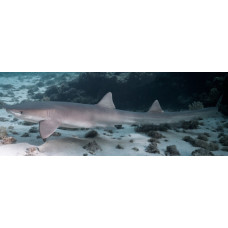Latin name
Chiloscyllium arabicum
Other name
Chiloscyllium arabicum
Identification
The Arabian carpetshark has a slender, almost cylindrical body and a relatively long, thick, rounded snout. The nostrils are set well back from the tip of the snout and are preceded by a pair of short antennae. The medium-sized eyes are set high on the head, with a small protrusion above each and large nostrils behind and below. The small mouth is set well in front of the eyes. There is a continuous skin fold on the chin, which surrounds the corners of the mouth. There are 26-35 upper teeth and 21-32 lower teeth. The teeth have a large central protrusion and a pair of lateral flaps. The five pairs of gill slits are short, with the fourth and fifth pairs very close together.
Features of fish fins
The pectoral fins of these sharks are small, broad and rounded; the pelvic fins are similar and almost as large. The two dorsal fins have straight posterior edges and are set well apart. The first dorsal fin is equal to or larger than the pelvic fins and begins behind the midpoint of the base of the pelvic fins. The second dorsal fin is slightly smaller than the first but has a longer base. A prominent ridge runs along the dorsal midline and continues between the dorsal fins. The long, keel-shaped anal fin begins behind the second dorsal fin. The caudal fin is low, without a lower lobe; the upper lobe has a strong ventral notch at the tip.
Fish colouring
Adults are light brown above and white below, sometimes with an orange tinge to the edges of the fins. Juveniles have faint pale spots on their fins.
Distribution
The range of this shark species extends from the Persian Gulf to Pakistan and western India. It is abundant in the Persian Gulf during spring and summer and is rarely seen in Oman and India.
Habitat
The Arabian carpetshark inhabits coastal waters from 3-100 m (9.8-328.1 ft) deep, although most are found at depths greater than 10 m (33 ft). This bottom dwelling species prefers coral reefs, lagoons, rocky shores and estuarine mangroves.
Size
This species reaches a maximum known length of 78 cm (31 inches). Maximum published weight: 645.00g.
Behavior
The Arabian carpetshark can survive for some time without water.
Food and feeding habits
Often found in caves and crevices, this shark is a predator of bony fish and invertebrates.
Reproduction
Egg-laying fish, like other members of the family, with a breeding period of six months. The reproductive cycle has been documented in captivity: during copulation, the male holds one of the female's pectoral fins in his mouth while inserting a clamp into her cloaca for 5-15 minutes. Males have been known to bite the claws of rivals when fighting over females. Females lay an average of 33 eggs per year in batches of four, over a period of 20 minutes to two days. About 7% of these eggs are infertile. The eggs have adhesive tendrils that attach them to the coral and hatch in 70-80 days at 24°C (75°F). Newly hatched juveniles are less than 10 centimetres long. They reach sexual maturity when they are 45-54 centimetres (18-21 inches) long.
Fishing
The species is of little commercial interest. The Arabian carpetshark is caught in artisanal net traps as well as in bottom trawls and trawl nets. This shark makes up the majority of the catch in Kuwaiti shrimp trawls. It is also caught off Bahrain and probably elsewhere.
Relationship with a person
A small and harmless shark to humans. It can be kept in aquariums. The meat and possibly the fins of this shark can be used.
| Classification | |
| Phylum | Chordata |
| Class | Chondrichthyes |
| Squad | Orectolobiformes |
| Family | Hemiscylliidae |
| Genus | Chiloscyllium |
| Species | C. arabicum |
| Features | |
| Conservation status | Near Threatened |
| Habitat | Bottom |
| Life span, years | No information |
| Maximum body weight, kg | 0,645 |
| Maximum length, cm | 78 |
| Sailing speed, m/s | No information |
| Threat to people | Edible |
| Way of eating | Predator |
Arabian carpetshark
Tags: arabian carpetshark

